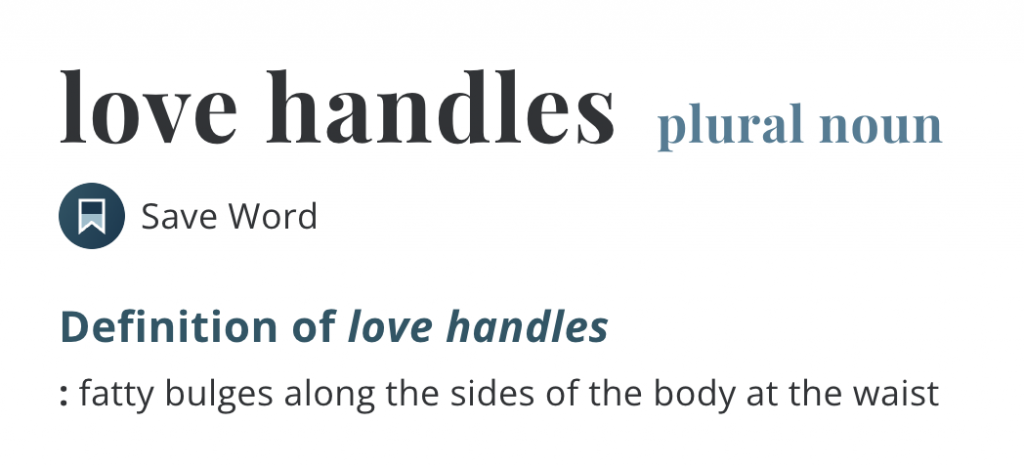It was my mom of all people who first explained the meaning of “love handles” to me. My teenage brain must have heard the term during an infomercial for one of the many mid-1990s fitness products that claimed to turn any kind of paunch into a six-pack overnight. Why I turned to my mom for clarity on this issue, I have no clue. But clarity she provided. “They’re called that because you can use them to hold onto someone you love,” she replied, with very little hesitation.
Mom or no mom as the messenger of this information, I was struck by the fact that such an undesired physical feature had been bequeathed such a tender-sounding name.
The Dawn of the Love Handle
The first reference to love handles in the modern context seems to be from a 1964 New York Daily News column called “The Unsinkable Debbie” by New York Film Critics founder Wanda Hale. In it, actress Debbie Reynolds — the mother of Carrie Fisher — was quoted as saying that her father, “in the idiom of the Southwest,” referred to a woman’s curves as “love handles.”
“Isn’t that sweet: love handles?” remarked Reynolds.
He apparently meant it more as a way of identifying a woman’s hip area as opposed to an assessment of flab — not that it makes it any better — but by the time Celestine Sibley wrote a 1967 article for the Atlanta Constitution about a national movement encouraging physical fitness amongst young women, the term “love handles” had fully morphed within its Southern female ecosystem to refer to “wads of fat around the midriff.”
Love Handles Turn Masculine
It only took a decade, however, before love handles were described as a predominantly male problem. “Just in case you don’t know what ‘love handles’ are, let me tell you,” Lois Lindauer, author and international director of “The Diet Workshop,” wrote in a 1975 newspaper column. “That’s the irreverent name medical students have given to the fistful of fat on either side of what was once a waistline. If you can grasp ‘love handles’ on your husband, he needs your help.”
From there, Lindauer defends her application of the term to men by pointing out the higher likelihood that they will materialize on a man’s body rather than a woman’s. “The facts are, ma’am, that the percentage of overweight women is 33 percent,” Lindauer claimed. “The percentage of overweight men is 52 percent. Male chauvinist pigs? More like male chauvinist hogs!”
Along those lines, Hartford Courant columnist Colin McEnroe devoted his column from April 30, 1984 to how famous American models and actresses like Linda Evans, Charlene Tilton, Cheryl Tiegs, Bo Derek and Christie Brinkley were recently asked their opinions on the “burning issue” of love handles on men. “All of those women were pretty grossed out by love handles,” explained McEnroe. “Among those polled, only Linda Evans and Charlene Tilton took the view that love handles are not a repulsive physical defect.”
McEnroe went on to talk about the then recent release of Chunks: An Intimate Look at Some Very Available Men, a book that explained how hunky men were in short supply, and that most women were left to choose from amongst the less desirable “chunks” who had been left behind. One of the most reliable ways to identify a chunk? By his conspicuous love handles, of course.
Love Handles Get Scientific
By the late 1980s, even widely respected medical professionals were frequently referencing “love handles.” Nationally syndicated columnist Dr. Lawrence Lamb regularly fielded questions from men who self-referenced their own love handles (e.g., “That roll of fat on each side of my waist really upsets me. Some people call them love handles”), although he dissuaded them from getting special surgeries or engaging in trunk-focused training activities in efforts to ameliorate them.
“You can’t get rid of those love handles by spot reducing,” responded Lamb to a letter from August 1988. “You tend to lose weight everywhere else but there with an exercise and diet routine. That is because love handles are specialized fat cells that are particularly resistant to giving up their fat stores. They are different from fat cells in your face that frequently empty first.”
Not that every physician found it to be a term of endearment. In August 1993, the Canadian Press polled experts who derided “love handles” as being a way to soften the onset of obesity. “All that cutesy stuff about love handles may actually be setting a person up down the road — there’s nothing loving about obesity-induced illnesses,” argued Dr. James Meschino, author of The Living Weigh: Seven Steps to Healthier Living.
“If the love handles are small and the person is in relatively good shape, they’re not such a big deal,” Dr. Rob Boyko added. “But, when you have contributing factors, you’re looking at trouble.”
As for why they seem to mainly afflict guys, the Centers for Disease Control surmised in a 1998 Washington Post article that the apple-shaped physiques of most men frame them perfectly for the acquisition of midsection fat, whereas the pear-shaped arrangement of most women’s bodies enabled excess fat to be distributed in areas that were further away from the midsection.
And that’s more or less where we find ourselves today. The science is set, and for better or worse, so is the nomenclature. In fact, the term “love handles” has such a hold on modern language now, it’s graduated far beyond an “idiom of the Southwest,” as Reynolds first described it, or even mere slang, being deemed an official part of the English language by no less of an authority than Merriam-Webster.


